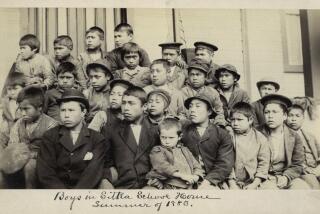‘Stones Into Schools: Promoting Peace With Books, Not Bombs, in Afghanistan and Pakistan’ by Greg Mortenson
- Share via
In a part of Afghanistan so remote it can take days if not weeks to journey there, the people are tired of fighting. First the Russians, then the Taliban. Now, they simply want to build a better life for the next generation.
“ ‘Look here. Look at these hills,’ [the leader of one such community] said as he pointed toward the mountains looming over the town, whose lower slopes were strewn with countless rocks and boulders. ‘There has been far too much dying in these hills. Every rock, every boulder that you see before you is one of my mujahadeen, shahids, martyrs, who sacrificed their lives. . . . Now we must make their sacrifice worthwhile. . . . We must turn these stones into schools.’ ”
The speaker of these words is Sadhar Kahn, a Tajik leader; his listener is Greg Mortenson, an American who’d been building schools in neighboring Pakistan.
Mortenson co-wrote the wildly successful “Three Cups of Tea,” recounting his efforts to build a single school in the isolated village of Korphe perched at the foot of the Karakoram Mountains.
He’d been inspired to action when the village nurtured him back to health after a failed mountaineering attempt on K2 in 1993. When he encountered the community’s thirst for education for its children and realized how unlikely it was that this thirst would be quenched, he set out to construct a single school.
What followed was a series of school-building projects that continue to spread through the region.
At the time of the new book’s printing, some 131 schools, many primarily for girls, had been built in Afghanistan and Pakistan, serving nearly 58,000 children (of which 40,000 are girls).
The philosophy is simple: Mortenson believes that conflict in the region will not be won by combat and airstrikes but with books, pencils and notebooks -- the tools of socioeconomic growth.
“Stones Into Schools” follows a clear trajectory with octopus tentacles of fascinating asides emanating from its core.
The main plot revolves around a 1999 promise that Dr. Greg (as he’s known to the locals) made to a group of horsemen who’d traveled a treacherous route to track him down and petition for a school in their remote home region within the Wakhan Corridor in the northeastern corner of Afghanistan.
Given all the things the people lack, what they desire most is the chance for their children to learn to read and write. Dr. Greg says yes with no idea how such a thing might come to pass.
Over the course of the book, readers follow in part how this promise comes to fruition after 10 years of effort, but we also follow the construction of countless other schools, women’s literacy programs, bridges and water delivery systems.
In the horrible aftermath of the massive October 2005 earthquake that decimated the Azad Kashmir region of Pakistan, Mortenson shifts his focus. Of the more than 80,000 casualties, a quarter were children, most in school when the quake hit; more than 9,000 schools were destroyed.
Throughout, Mortenson forges warm relations with Islamic clerics, works with tribal leaders and follows the guiding principle that made his first school effort successful: the idea that one must spend time listening to the community -- at least the time it takes to enjoy three cups of tea together -- to fully understand and be in a position to help.
Unlike “Three Cups of Tea,” which was co-written by David Oliver Relin and described Mortenson’s exploits in third person, “Stones Into Schools” is written from the author’s perspective.
It’s odd then, given this first-person treatment, that the narrator’s voice remains muted, giving readers objective information with scant effusive emotion.
There’s less about his personal life -- in the first book, the story of his falling in love and marrying quickly added spice that kept the work from feeling heavy.
The new book is less focused on the plot drive found in “Three Cups of Tea” -- will he succeed or fail to build the school? -- and more concerned with educating readers about the region, the religions represented, the tribal customs and countless other details that animate the area.
The amount of history and background provided is epic; the slew of maps and pages of “Who’s Who” at the book’s beginning are needed to keep readers on track.
The result is that those who were lured by the conversational tone of “Three Cups of Tea” might have become interested enough to wade deeper into the region’s complexities, as presented in “Stones Into Schools.” Readers not so initiated may struggle.
Though “Three Cups of Tea” is not prerequisite reading -- most of the material is recapped in the new book -- it may serve to whet readers’ appetites.
“Stones Into Schools” has more characters, more regions to consider, more obstacles to overcome, more history to digest. At times, these “mores” can require a slow and careful read.
But be not discouraged: Like the trouble it takes to build these important and life-enriching schools, endeavoring to better understand this region through “Stones Into Schools” is worth the effort.
Murphy has published three books of narrative nonfiction and is the author of a forthcoming novel, “Grace Notes.”
More to Read
Sign up for The Wild
We’ll help you find the best places to hike, bike and run, as well as the perfect silent spots for meditation and yoga.
You may occasionally receive promotional content from the Los Angeles Times.










